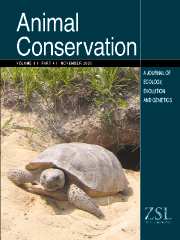Crossref Citations
This article has been cited by the following publications. This list is generated based on data provided by
Crossref.
Mills, Michael D.
Rader, Russell B.
and
Belk, Mark C.
2004.
Complex interactions between native and invasive fish: the simultaneous effects of multiple negative interactions.
Oecologia,
Vol. 141,
Issue. 4,
p.
713.
Ayala, Jill R.
Rader, Russell B.
Belk, Mark C.
and
Schaalje, G. Bruce
2007.
Ground-truthing the impact of invasive species: spatio-temporal overlap between native least chub and introduced western mosquitofish.
Biological Invasions,
Vol. 9,
Issue. 7,
p.
857.
Slaughter, Joe E.
and
Jacobson, Brad
2008.
Gape: Body Size Relationship of Flathead Catfish.
North American Journal of Fisheries Management,
Vol. 28,
Issue. 1,
p.
198.
Billman, Eric J.
2008.
Reproduction by June Sucker in a Refuge Population: Successful Spawning in a Lake Habitat.
Western North American Naturalist,
Vol. 68,
Issue. 4,
p.
475.
Billman, Eric J.
2008.
Observations of shoaling and feeding behavior of June sucker, Chasmistes liorus, in a refuge population.
Western North American Naturalist,
Vol. 68,
Issue. 3,
p.
390.
Billman, Eric J
and
Belk, Mark C
2009.
Growth and Survival of Juvenile June Suckers in Enclosures in Utah Lake: Feasibility of Modified Cage Culture for an Endangered Species.
North American Journal of Aquaculture,
Vol. 71,
Issue. 3,
p.
281.
Kappenman, Kevin M.
Webb, Molly A. H.
Cureton, Elijah S.
and
Ilgen, Jason
2010.
Determination of Upper Temperature Tolerance in June Sucker Larvae: Is the Transition to Utah Lake Temperatures a Recruitment Bottleneck?.
Transactions of the American Fisheries Society,
Vol. 139,
Issue. 5,
p.
1386.
Belk, Mark C.
and
Tuckfield, R. Cary
2010.
Changing costs of reproduction: age-based differences in reproductive allocation and escape performance in a livebearing fish.
Oikos,
Vol. 119,
Issue. 1,
p.
163.
Kreitzer, Joshua D.
Billman, Eric J.
Belk, Mark C.
and
Rader, Russell B.
2011.
Growth of Young June Sucker (Chasmistes liorus) is Associated with Zooplankton Density in Utah Lake.
Western North American Naturalist,
Vol. 71,
Issue. 4,
p.
499.
Billman, Eric J.
Rasmussen, Josh E.
and
Watson, Jackie
2011.
Evaluation of Release Strategies for Captive-Reared June Sucker Based on Poststocking Survival.
Western North American Naturalist,
Vol. 71,
Issue. 4,
p.
481.
Brischoux, F
and
Lillywhite, HB
2013.
Trophic consequences of pelagic life-style in yellow-bellied sea snakes.
Marine Ecology Progress Series,
Vol. 478,
Issue. ,
p.
231.
Archer, SK
and
Crowl, TA
2014.
Retention of learned predator recognition in an endangered sucker Chasmistes liorus liorus.
Aquatic Biology,
Vol. 20,
Issue. 3,
p.
195.
Strohm, Deanna D.
Budy, Phaedra
and
Crowl, Todd A.
2017.
Matching Watershed and Otolith Chemistry to Establish Natal Origin of an Endangered Desert Lake Sucker.
Transactions of the American Fisheries Society,
Vol. 146,
Issue. 4,
p.
732.
Crossman, J. A.
Scribner, K. T.
Forsythe, P. S.
and
Baker, E. A.
2018.
Lethal and non-lethal effects of predation by native fish and an invasive crayfish on hatchery-reared age-0 lake sturgeon (Acipenser fulvescensRafinesque, 1817).
Journal of Applied Ichthyology,
Vol. 34,
Issue. 2,
p.
322.
Gaeta, Jereme W
2019.
A Web Tool to Estimate Prey Fish Lengths Consumed by Common Freshwater Piscivorous Fishes.
Fisheries,
Vol. 44,
Issue. 6,
p.
293.
Belk, Mark C.
and
Tuckfield, R. Cary
2019.
Demography of an endangered, long‐lived fish: Informing management options in the face of cyclic and stochastic climate variation.
Population Ecology,
Vol. 61,
Issue. 3,
p.
349.

